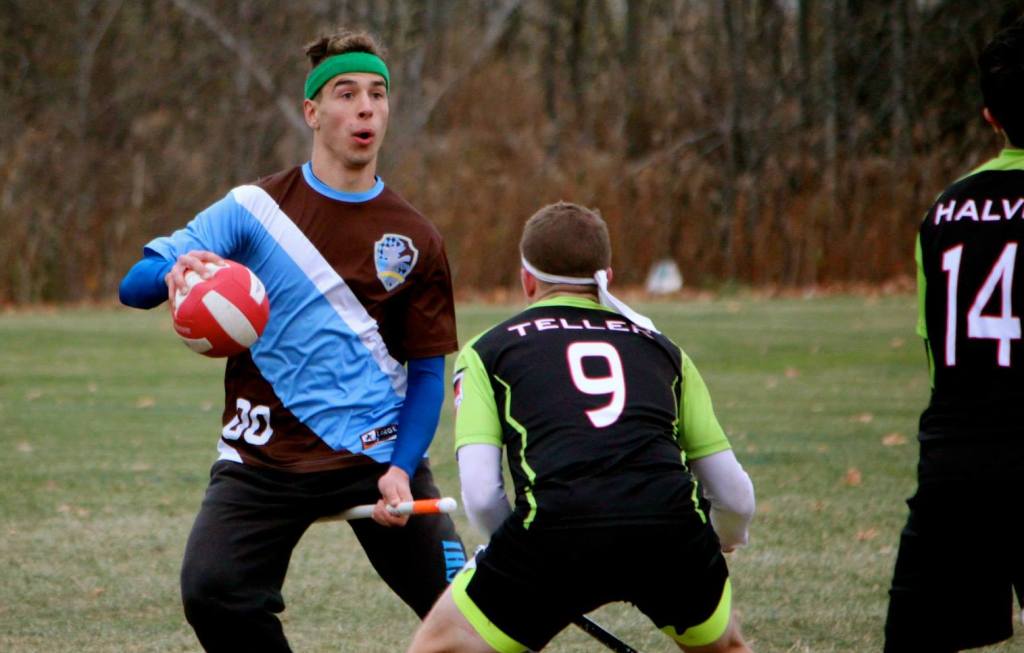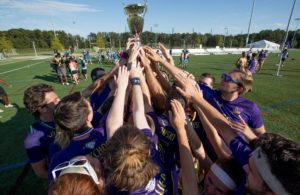- Rule, Britannia, no more?
- Unpopular Opinions: US Quadball Cup 2023
- Proven Contenders: University of Virginia
- Proven Contenders: Rutgers University
- Proven Contenders: University of Michigan
- Proven Contenders: Creighton University
- Different Perspectives: A Look Inside USA Ultimate
- Antwerp QC, Much of Belgian Core, Leaves Competitive Quidditch
Tale of Two Cities: Northeast Regional Recap
- Updated: November 21, 2014
My last article on a regional tournament criticized some policies that were in place for the Mid-Atlantic Regional Championship; I want to start my Northeast recap by commending the USQ for addressing those issues. I do not know if this type of response is going to become a habit, but I enjoyed it. Two distinct issues stood out to me after the Mid-Atlantic Regional Championship. The first was a problem with referee consistency, including several rules which were shown to be misunderstood. USQ was quick to put out clarifications to the referees (granted I wrote these myself) and made a solid attempt to improve policy enforcement before upcoming regionals. Further to its benefit, the Northeast Regional Championship had a plethora of capable certified referees, which at the very least shows that the reffing situation has stabilized itself for this season. There were still some ref issues, but I am hoping this is the start of an upward trend. The second issue I brought up from the Mid-Atlantic Regional Championship is the forfeit policy. The policy was recently changed so that forfeiting a game resulted in forfeiting the tournament. Several teams were almost subject to forfeitures because they did not get volunteers to fields on time, but they ran when they realized what was on the line, and it kept the tournament on schedule to end before dark.
Tufts University won their second tournament and Boston University lost their first regional. The 12 most-predictable teams qualified for World Cup and the way the bracket fell made for some very interesting paths to get there. RIT and Boston University needed to go through the loser’s bracket to get their bids, and two of the quarterfinalist teams suicided after securing their berths.
RIT came into this tournament looking to prove something, even bringing back star beater Josh Kramer at the last minute to guarantee a strong performance. In the end, they went 4-3 at this tournament, falling once to University of Rochester and twice to Emerson College, two teams that have been struggling to perform this season. While I would still have picked RIT over Emerson in both their contests—and, in fact, the second was really decided by a missed call—Rochester outplayed their RIT rivals. Rochester matched against RIT in an early time slot, coming back from a 30-0 deficit to take over the game in terms of both quaffle and bludger play and eventually winning comfortably out of range.
Rochester’s achievements cannot be understated here, as this is a team that was uncertain they would qualify. This team—which has been famed for the sport’s darling Devin Sandon—has long forced him to be the ball carrier and star despite the fact that he is better suited to support. This tournament, however, there were new options. Sandon never had to bring up the ball and it was wonderful. Aside from their win over RIT in pool play, they also took the eventual tournament champions, Tufts, to overtime in the quarterfinals.
That quarterfinal round also saw QC Boston: The Massacre and The Warriors through, via suicide pulls by their opponents (RPI and Hofstra University, respectively), while New York University proved they were the best in purple, dominating Emerson. This set the semifinal stage perfectly, with the Boston teams on one side of the bracket and the New York teams on the other. From a spectator’s point of view, we could not have hoped for anything better, with the guarantee of the New York versus Boston final.
The New York side of the bracket boasted NYU, favored on their Northeast Classic hype train versus The Warriors. The Warriors kicked off the match firing on all cylinders and gaining a quick 60-20 lead. However, that was short lived. Possibly due to overconfidence from their dominant 180*-80 win over NYU at Keystone Cup, The Warriors fell apart in the later period of the rematch and couldn’t hang in range when the snitch stepped on pitch. The Dallas Yadas bowed out of their second semifinal appearance (the first being last year’s Mid-Atlantic Regional Championship).
The Boston side of the bracket was a much more interesting battle. Honestly, I would have picked Massacre to win and, for the most part, I still think they are the better team—better chasers, better keepers, better beaters. However, there is a gaping hole. Massacre cannot deliver with their seeking game. They managed to stay ahead the entirety of the game and were either 30 or 40 points up for most of the snitch’s time on pitch, but they could not end it. A great seeker is not only the difference between winning and losing close games but also the difference between turning a 70-point win into well over 100. If your opponent is out of range but is confident you will not catch, then they can afford to keep their beaters on the quaffle and stay in the game. So Tufts stayed in the game, trading shots and getting a few unanswered, just enough to put the game on the line, and they caught, thus preventing a Northeast Classic finals rematch.
The finals pitted Tufts against NYU for the first time this season but was not really a game until about seven minutes in. It was a shooting contest with both teams putting up about as much defense as the French in World War II. At five minutes, the score was 50-50, meaning there was a goal every time someone went down the pitch. Both teams played very aggressively with their beaters causing chaos on offense and showed off a longshot game that most teams cannot rely on. Tufts, especially, relied heavily on keeper David Stack to be an outside threat. When the snitch came out, Tufts commanded a nice lead, never letting it shrink below 30 for more than a few seconds. With the snitch on pitch, Tufts kept their head on their shoulders, while it looked like the NYU players let the pressure get to them, missing shots they needed in order to stay in the game. NYU had a chance to tie for a long period of time, and my money would be on them in an overtime as their seeker, Austin Sweeney, was by far the best on the pitch. It never came to that, however, as the snitch, Harry Greenhouse, outlasted the seekers and allowed Tufts to pull further ahead as game played on. Sadly though, there are snitch handicaps, even in tournament finals, so the snitch was stuck standing on the center dot with one arm to defend himself after 35 minutes.
The biggest takeaway from this tournament is that these teams are playing smart. NYU showed it when they scored an own goal to release their seeker from penalty time at Northeast Classic, and Massacre was calling out plays all day. These things are not remotely impressive in other sports but is a refreshing change for quidditch, which has been oversimplified for too long. Beyond that, we have the obvious point: that teams in the Northeast really like to run two-male beater sets. They balance out the potential loss of physicality at chaser by using the beaters to turn defenses into swiss cheese, leaving chasers open by the hoops who—as long as they can catch a pass—can score. The Northeast is not going to beat the Southwest in terms of physicality or athleticism, but as the University of Texas vs. University of Maryland game at World Cup VII showed us, the Southwest teams can struggle against those that implement smart strategies with which they are unfamiliar.




